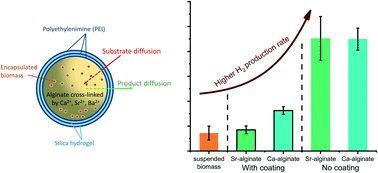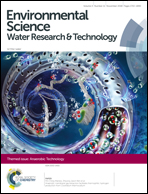Achieving high-rate hydrogen recovery from wastewater using customizable alginate polymer gel matrices encapsulating biomass†
Abstract
In addition to methane gas, higher-value resources such as hydrogen gas are produced during anaerobic wastewater treatment. They are, however, immediately consumed by other organisms. To recover these high-value resources, not only do the desired phenotypes need to be retained in the anaerobic reactor, but the undesired ones need to be washed out. In this study, a well-established alginate-based polymer gel, with and without a coating layer, was used to selectively encapsulate hydrogen-producing biomass in beads to achieve high-rate recovery of hydrogen during anaerobic wastewater treatment. The effect of cross-linking agents, Ca2+, Sr2+, and Ba2+, as well as a composite coating on the beads, consisting of alternating layers of polyethylenimine and silica hydrogel, were investigated with respect to their performance, specifically, their mass transfer characteristics and their differential ability to retain the encapsulated biomass. Although the coating reduced the escape rate of encapsulated biomass from the beads, all alginate polymer matrices without coating effectively retained biomass. Fast diffusion of dissolved organic carbon (DOC) through the polymer gel was observed in both Ca-alginate and Sr-alginate without coating. The coating, however, decreased either the diffusivity or the permeability of the DOC depending on whether the DOC was from synthetic wastewater (more lipids and proteins) or real brewery wastewater (more sugars). Consequently, the encapsulation system with coating became diffusion limited when brewery wastewater with high chemical oxygen demand was fed, resulting in a lower hydrogen production rate than the uncoated encapsulation systems. In all cases the encapsulated biomass was able to produce hydrogen, even at a hydraulic residence time of 45 min. Although there are limitations to this system, the used of encapsulated biomass for resource recovery from wastewater shows promise, particularly for high-rate systems in which the retention of specific phenotypes is desired.

- This article is part of the themed collection: Anaerobic Technology


 Please wait while we load your content...
Please wait while we load your content...